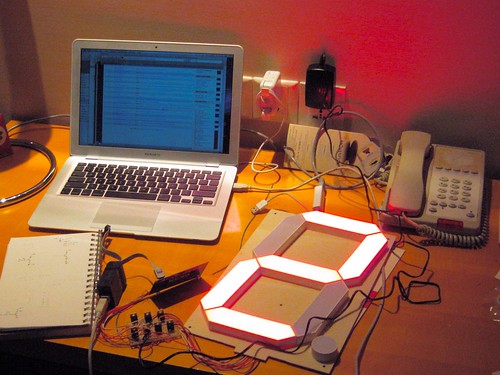
As part of the China trip last week, we had a little scavenger hunt, where the challenge was to build something with parts and tools acquired at the electronics markets.
Here’s what I found: a single-digit seven-segment LED display with twelve inch digit height. (Whoa!)
When I came across this display, it was in the display case of a vendor at the SEG electronic market– it was too tall for the display area so they had to put it in sideways, next to the 8″ displays. (It’s the one with the green protective film.)
I’m guessing that they don’t sell too many of these because they didn’t have a datasheet handy. They showed me some similar displays in their catalog, indicating how each segment is wired up, and somehow communicated to me that the internal wiring of the 12″ digit segments had 15 x 4 LEDs: four LEDs in series, fifteen times in parallel. While that would be nice– meaning that it could be run off of about 9 V DC, it seemed a little improbable, based on what I know about big LED displays. So, I shopped around and got both a 12 V power supply and a 24 V power supply, just in case.

Each segment of the display is an independent piece of molded plastic, on a huge but inexpensive circuit board. The circuit board is mainly just a mechanical fixture to hold the segments in the right places.
WIthin each segment is indeed a 15×4 array of superbright red LEDs, but it turned out to be 15 in series by 4 in parallel. It runs okay at 100 mA, which takes about 21 V across the LED part. (Good thing that I picked up that 24 V power supply.)
My driver circuit is shown above on the left– an AVR microcontroller just turns on the transistor to drive the segment. On the right, a photo of the seven transistors on a little protoboard. I put it all together with a $3 soldering iron.
Tom Igoe (or possibly someone borrowing his camera) managed to take several good photos as we all worked together building things late at night in a bar at the hotel.
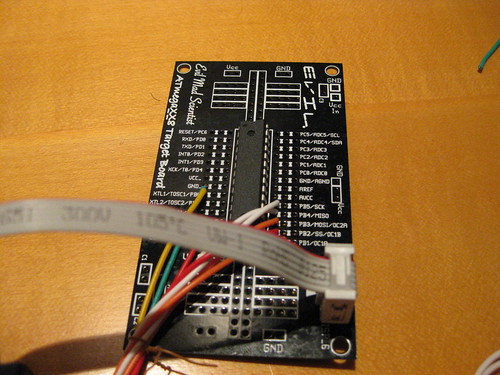
Here’s the microcontroller part of the setup. I used one of our target boards to just drive the seven transistors as GPIO outputs. The ATmega168 was purchased locally. There’s nothing on this board except for the microcontroller, the programming header, and the wires to the transistor drivers. Power was provided by USB, through my USBtinyISP.
(Note: the scavenger hunt rules were a bit nebulous, but it had been agreed upon that everyone was allowed access to Arduino-class development tools.)
And it’s almost painfully bright. You can see the wall being lit up by the pure red glare, while the segments themselves,also pure red, only give washed out colors on a digital camera. Not a problem: you can always turn brightness down. :)
Embedded video #1: A “hello world” demo put together in the hotel room in Shehzhen:
Embedded video #2: A demo put together back home in California: A single-digit clock.
There’s some interesting potential here. (Of course, maybe six in a row would look better).
Finally since everyone else has been as excited about these as we are, we now have 12-inch LED displays available at our web store. Woo!




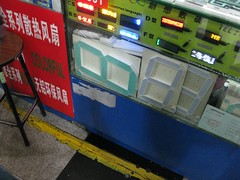

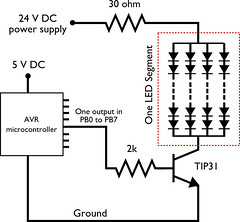
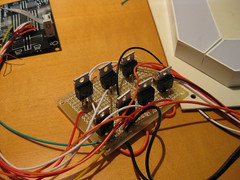


Cool. Bigger always is better. ;-)
And, I like the serial digital clock. However, I’m still waiting for someone to implement a one bit clock, where the time is sent by flashing the single LED the appropriate number of times (e.g., 12:47 would be blink blink-blink blink-blink-blink-blink blink-blink-blink-blink-blink-blink-blink). Unfortunately, as near-sighted as I am, I wouldn’t even be able to read a 12 inch clock without my glasses from much more than a few feet away (Yes, I’m THAT near-sighted.).
Dave
Well, we’re getting 20-inch displays next, so maybe that would be better?
—
Windell H. Oskay
drwho(at)evilmadscientist.com
http://www.evilmadscientist.com/
I bet the Spark Fun guys wish they knew about these a few years ago!
http://www.sparkfun.com/commerce/tutorial_info.php?tutorials_id=47
Nathan from Sparkfun was one of the people in our group. Didn’t look like he had anything to regret about that project!
—
Windell H. Oskay
drwho(at)evilmadscientist.com
http://www.evilmadscientist.com/
Hi guys,
I love this site!
I live in Shenzhen, so if you need help getting more of those 12 inch digits (or anything else) just let me know.
I go to Hua Qiang Bei (the electronics market in Shenzhen) all the time to drool over all the gizmos and components for gizmos.
Cheers
Erik
As I am severely nearsighted, I could use these to build a clock I can actually see from my bed with my glasses off. Of course, it would be so bright we’d never actually be able to get to sleep, unless I drove the things at extremely low power.
(And there’s also the little matter of it costing over $300… not sure my wife would be too keen on that.)
I too could do with a clock with digits that size. At the moment I sleep about a foot from a standard size LED clock and I can still barely make out the time when I wake in the night! Though I also may struggle if the price tag is $300.
Martin
I don’t get it. Why would something like this cost $300 ?
~ Matt, [link:www.traveladriatic.net]
May be because it would take at least four of them?
One solution to clock-is-too-bright is the computer with voice-activated response. My old iMac running OS 9 with monitor off will reply to voice command "Computer, what time is it?" with the audio response.
Another is 16 10mm LED’s mounted into a plastic pipe, displaying the time in BCD. mine alternates between 4-digit year, 2-digit month + day of month, and 2-digit hour + minutes.
Any larger, and those 7-segment displays can be read from space. They probably already can be seen from space.
could you show or help us in creating the flow chart of the count down clock or give us any example and we will further modifier similer thing here is my E-Mail Lwandle2@webmail.co.za
Erik,
Do you have a source for extremely large 7-segment displays? 12" is good! 15" even better. If they aren’t too expensive, I’d buy 100 at a time.
David Haile
Fort Collins, CO USA
haile dot david at gmail dot com
hi
i would like to know where u bought ur display from
From the article:
He found them in China, and now sells them in his web store.
Hmm, odd, it gets an error if I include a link to the web store in my comment. Anyways, the link is in the last sentence of the article.
I’m very sorry about that error- I reported it yesterday and the developers of our CMS (glfusion) have just sent me a new library that should fix it. Fingers crossed.
Windell H. Oskay
drwho(at)evilmadscientist.com
http://www.evilmadscientist.com/
Hi Erik.
Thanks for your offer. Have you seen any 15" or 16" displays similar to this one? That would be the ideal size for my application.
Thanks ……. =PR=
Hello!
Can you provide additional information on how to controll it?
I’m not sure what you’re asking… we explained how we controlled it in this article.
Windell H. Oskay
drwho(at)evilmadscientist.com
http://www.evilmadscientist.com/
Hi there,
I know you keep saying "they’re bright"… but do you think they’d be bright enough for an outside scoreboard application (ie: sunlight and visibility from ~100m)?
I should be able to keep it from having morning/afternoon sun angled into the display, but during the day it would be out in the ambient sun. I’d probably have a sheet of perspex (either red or clear) over the front of the display.
Thanks!
That’s a bit of a trick question; the one here that we found at the market is not identical to the one that we’re selling at our store, so "they" is not well defined in this context.
In general, the white-diffused segments (or generally, white-diffused LEDs) are not for use in direct sunlight because they tend to "light up" when you shine that much light on them. Putting them behind transparent red plexiglass is a fine way to increase the contrast to the point that they can be used in sunlight. The other solution is to get the version with clear epoxy instead of diffused, which is somewhat more optimal for outdoor applications.
Windell H. Oskay
drwho(at)evilmadscientist.com
http://www.evilmadscientist.com/
hehe …. ok ok.
So let me ask your opinion.
If I were to purchase some of the clear epoxy units from your store, mount them behind a sheet of translucent red perspex and operate them outside at noon on a sunny day, do YOU THINK the numbers would be legible from a distance of 100m.
I’m aware that this is an opinion, and in no way any sort of guarantee of operation… but finding cost effective displays of this size has become a bit of a nightmare … the electromechanical ones (yellow black flip digits) seem to be horrendously expensive …. so I’m willing to work with educated opinions.
>do YOU THINK the numbers would be legible from a distance of 100m.
Yes. Might be better to go for the larger digits (16" or 20") though, just for size.
Windell H. Oskay
drwho(at)evilmadscientist.com
http://www.evilmadscientist.com/
Sorry… you might have to excuse my ignorance here… I couldn’t find the 16" or 20" on your site? Do you stock them?
No, they’re not stock items– our web store only gets them by special order. If you’re interested, please contact our web store directly.
Windell H. Oskay
drwho(at)evilmadscientist.com
http://www.evilmadscientist.com/
I am beginner to this,, and planning to use this type of led display for a digital scoreboard. When thing i did not understood is how you programmed it from the computer. What software you used? Any details around that will be great. thx/ ha
Bought the display and the driver hoping it would work for an outside scoreboard… Well it might if the thing was only used at night. These digits are not bright enough in direct sun to be used for this purpose. When I powered it up for a test, I thought the power to the unit was not working. As my shadow crossed the display, it was obvious that the segments were on but not visible in the daylight. I suspect it has as much to do with the brightness of the LEDs as it also does with the translucent cover over them. I’m sure it does not help with the sunlight bouncing around in it. I will attempt to take the segment apart and figure out how I might get it to work with a clear cover.
The kit itself went together without a hitch… well one. The hex wrench they sent with the kit did not match the screws it was intended to assist with. Easy enough to fix with a trip to the tool box. The instructions were top notch and very easy to follow. Great packaged solution. Keep up the great work!
The displays at our store have diffused segments, which is not the type designed for use in direct sunlight. To use them outdoors, they should get a sun shade (like traffic signals have) or be placed behind a piece of translucent red or smoke colored plastic to increase the contrast.
Windell H. Oskay
drwho(at)evilmadscientist.com
http://www.evilmadscientist.com/
we are using a 4 inch seven segment display and we are having trouble with its driver circuit. Can you help us please…. We are using a 8052 micro controller and connecting the display with it. As you know that 8052 works on 5V and 0V so we are having trouble switching the led of the segment off. We would appreciate if you can help us in any way. Thank you :)
That’s not *nearly* enough info to go on– the driver spec needs to be tuned to the current and voltage properties of the segments. If you’d like any advice on this, please redirect this discussion to our forums.
Windell H. Oskay
drwho(at)evilmadscientist.com
http://www.evilmadscientist.com/
Hello Erik,
I live in Shenzhen too. Let’s go to Shenzhen’s hackerspace! Can you send me your email address to 158 1444 2079? Thanks
Living in Shenzhen is like living in Bladerunner City. I see stuff here every day that would bug your eyes out.
Mitch.